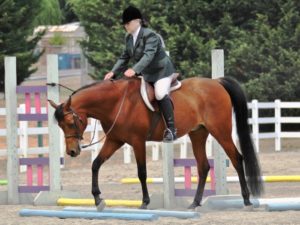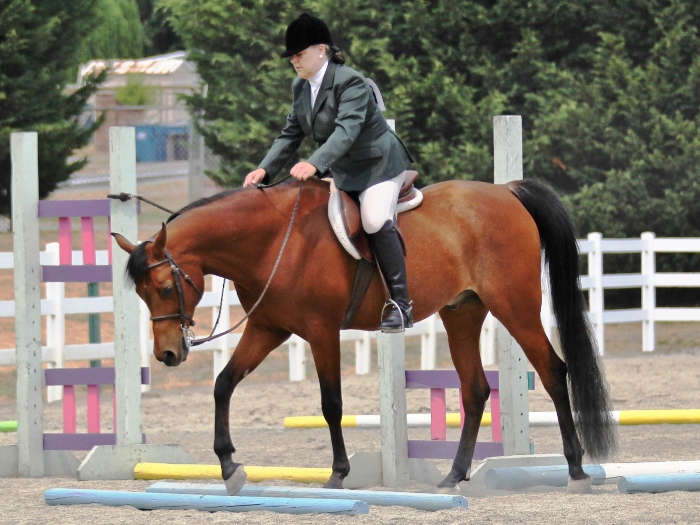by Jackie Davenport
In the horse show world nothing is static: events develop, new events are added, rules change and rules are added as needed. The relatively recent addition of English riding styles to arena trail or, “English trail” as I call it, is one of these evolutionary steps. English trail is still in its infancy as an event and is sure to evolve as more people participate. Today we’re seeing primarily hunter type horses join in this new event, but it’s open to any English style horse. I expect we’ll see saddle seat, show hack and other styles join in as riders learn how fun this challenging event can be.

English trail is a working class with between six to eight obstacles or groups of obstacles which the horse and rider must maneuver around, over and through while exhibiting confidence, curiosity and athleticism. They are taken from the original western class and include bridges, gates, back-throughs and, of course, walk, trot and canter obstacles. That said, English trail is not just western trail in an English saddle; the courses are usually spread out more than a western course to accommodate the longer stride of an English style horse.
This event is designed to show the athleticism, willingness and overall training of the horse. It requires a lot of practice at home so your horse is prepared for the obstacles it might encounter at the show. The English trail horse should be solid in its walk, trot and canter gaits and bold enough to get through the obstacles before going to a show. English trail provides an excellent opportunity for an English type horse to perform in a working class that is not a jumping or driving course. To excel in this event, horses must be able to stride out to a 4’ to 4.5’ trot and a 7’ to 8’ canter. Riders who typically work to that stride on the “flat” should also be prepared for a small jump, typically a cross-rail of no more than 2 feet (1.5’ for amateurs, 2’ for open classes). And, of course, various other poles may be raised just as in the western version of the event.
As with other English events, the horse is shown with two hands so this class is a perfect opportunity to work an inexperienced trail horse that is beyond its junior horse years. Additionally, English trail horses need not be as collected as you’d expect of, say, a hunter pleasure horse. The horse must be collected, yes, but only to a degree that still allows them freedom to use their head and neck as they travel over and around the obstacles. English trail can also be a welcome change for that ring-sour horse that’s learned to anticipate the announcer’s call!
To meet the requirements of this event, one must be in proper attire, meeting the USEF or breed specifications for the “flat” version of their English discipline. Today, a strapless hunt cap or derby is generally accepted, but protective headgear may be worn without penalty. The horse must also be tacked up in its corresponding and proper flat class equipment. You’re currently not required to braid as you might for a flat class. This may evolve but I prefer not to braid as a tightly braided mane might inhibit a horse’s ability to lower his head such as when navigating a walk-over or bridge. To post or not to post is also an evolving topic. Poles in trot-over obstacles will usually be set to accommodate a posting English trot, but I advise my riders to sit the trot when executing serpentines or any other trotting obstacle that requires arcing, circling or is too compact to accommodate a solid posting stride.
English trail will continue to evolve in its own manner, out from under the shadow of western trail. If you’re looking for an event that can help you add miles to your green trail horse or that challenges the abilities and intellect of you and an old partner, check out the English trail classes at your next local show.
Published in November 2015 Issue
Jackie Davenport has been putting the foundation and finish on champions for over 30 years. She has trained multiple national champions and currently specializes in riders with goals that include wins at the national and regional levels of the Arabian circuit. Jackie has also produced many winning horse and rider teams in the Quarter Horse, Paint, Appaloosa, Pinto and Morgan arenas and has judged at a variety of venues. Jackie’s consistent, foundation-oriented training methods produce results. Her methods are based on fair treatment and education for both the horse and the rider. Visit jackiedavenport.comjackiedavenport.com or follow her on Facebook.






